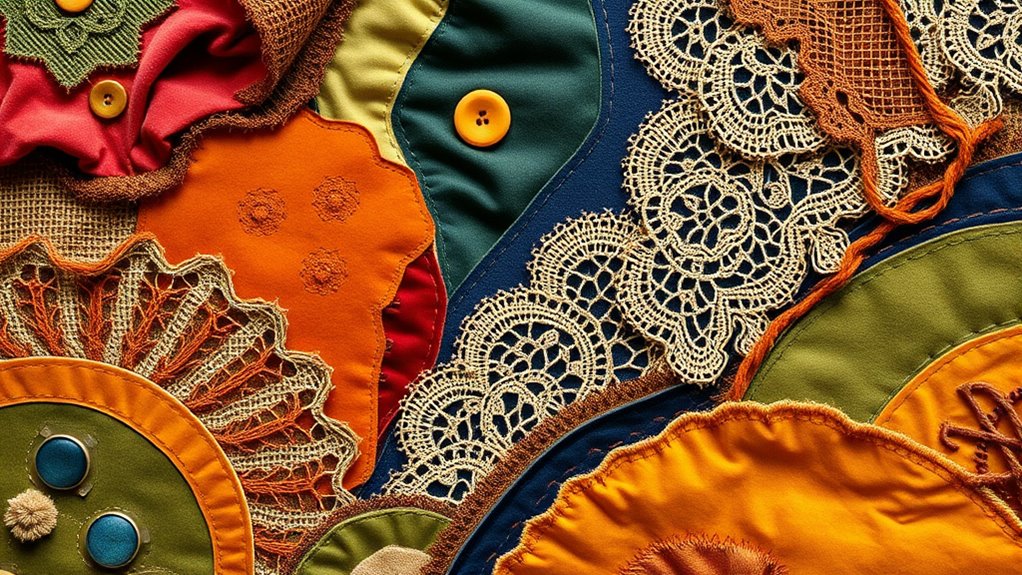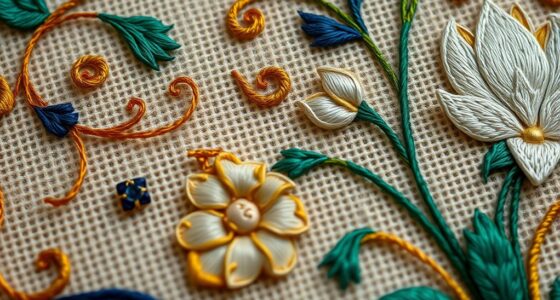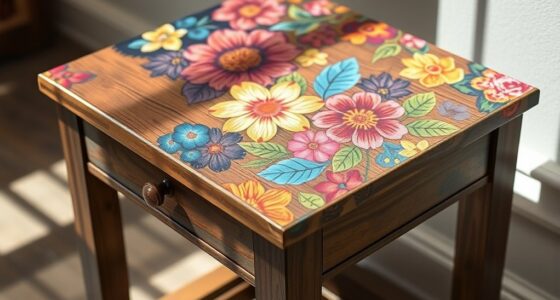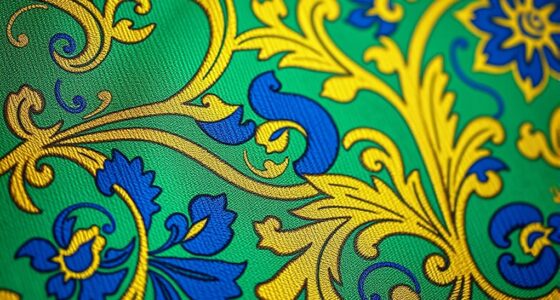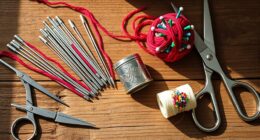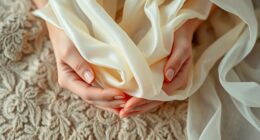To create fabric collage wall hangings, you’ll layer various textiles like silk, cotton, or velvet to build texture and depth. Use sewing, gluing, or embroidery to secure pieces, and mix in mixed media elements like beads or paper for added interest. Play with positioning and overlapping fabrics to tell a story or evoke emotion. If you want to discover creative techniques and tips for stunning results, there’s more to explore below.
Key Takeaways
- Use diverse textiles like silk, cotton, and velvet to create rich textures and visual interest in wall hangings.
- Layer fabrics thoughtfully, starting with a sturdy base and building with overlapping pieces for depth.
- Incorporate techniques such as appliqué, embroidery, and fabric painting to enhance texture and detail.
- Secure fabric layers with sewing or adhesive, experimenting with frayed edges or uneven cuts for organic effects.
- Personalize your artwork by combining mixed media elements like beads, paper, or found objects for added dimension.
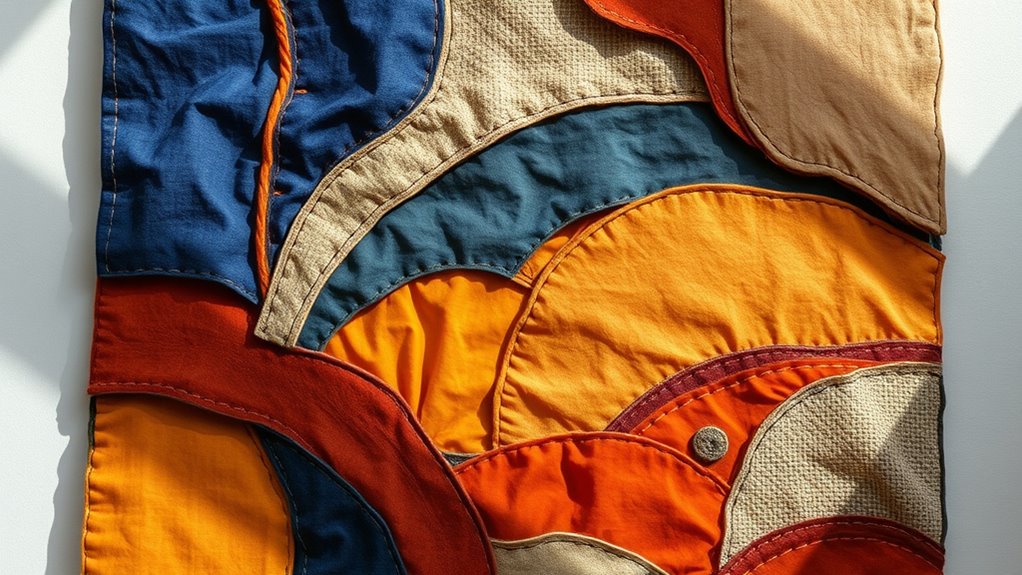
Fabric collage art combines various pieces of fabric to create visually striking and textured works of art. When you immerse yourself in this craft, you’re exploring a world where textile techniques and mixed media approaches come together to produce dynamic, tactile pieces. You’re not just assembling fabric pieces; you’re crafting a layered narrative, playing with color, texture, and form to evoke emotion and interest. This approach allows you to experiment with different textiles—silks, cottons, velvets, and even unconventional materials like lace or burlap—to add depth and complexity to your wall hangings.
Fabric collage art blends textiles and mixed media to create textured, layered, and expressive wall hangings.
Using textile techniques in fabric collage art involves more than just sewing pieces onto a base. You might incorporate appliqué, where you cut out shapes from fabric and sew or glue them onto your background to create bold designs. You could also explore freehand embroidery or quilting stitches to add intricate details and texture, making each piece uniquely yours. These textile techniques help you build dimension, giving your artwork a tactile quality that invites viewers to touch and explore. You might also employ fabric painting or dyeing to further customize your textiles, blending colors seamlessly or creating interesting patterns that set the tone for your piece. Additionally, understanding the importance of contrast ratio in visual elements can help you achieve more striking and balanced compositions.
Mixing media approaches is fundamental to fabric collage art. You don’t have to limit yourself to textiles alone; integrating other materials like paper, beads, or found objects can elevate your work. For example, you might layer fabric with paper cutouts for a collage effect, or embed small embellishments to add sparkle or texture. This blending of different media encourages creativity and allows you to craft highly personalized wall hangings, combining the softness of fabric with the visual interest of mixed media elements. The key is to experiment with how different materials interact—how they overlap, contrast, or complement each other—so your finished piece feels balanced and engaging.
As you assemble your fabric collage, think about composition and layering. Start with a sturdy backing, then build up your layers thoughtfully, allowing each piece to contribute to the overall story or aesthetic. Use adhesives, sewing, or a combination of both to secure your textiles in place. Play with the arrangement until it feels right, keeping in mind that uneven edges or frayed fabrics can add a sense of organic chaos or vintage charm. Ultimately, fabric collage art is about expressing your personal style through layered textiles and mixed media approaches—transforming simple scraps into captivating wall hangings that tell a story and invite tactile exploration.
Frequently Asked Questions
What Types of Textiles Work Best for Fabric Collage Art?
When choosing textiles for your fabric collage, focus on variety in fabric texture to add visual interest. Opt for durable textiles like denim, canvas, or heavy cotton to guarantee longevity, especially if your piece will hang in a busy area. Mix smooth and rough textures for depth. Avoid delicate fabrics that might fray or tear easily. Balancing fabric texture with textile durability helps create a vibrant, lasting wall hanging you’ll enjoy.
How Do I Preserve or Protect Fabric Collages Over Time?
Imagine safeguarding your heartfelt creation like a treasured story. To preserve your fabric collage, use antique textile preservation techniques, avoiding direct sunlight and humidity. Frame your artwork with acid-free materials, employing fabric collage framing techniques that support the piece without damage. Regularly inspect it for wear, and consider professional conservation if needed. Your art’s enduring beauty reflects your love—protect it with care and reverence, ensuring it tells its story for years to come.
Can Fabric Collage Art Be Created With Recycled or Vintage Textiles?
Yes, you can create fabric collage art using recycled or vintage textiles, promoting sustainable art and vintage textile reuse. Incorporate old fabrics to add unique textures and stories to your piece, making it eco-friendly and meaningful. Just guarantee you clean and treat vintage textiles properly to preserve their integrity. By repurposing these materials, you contribute to sustainability while crafting one-of-a-kind wall hangings that showcase history and creativity.
What Tools Are Essential for Assembling Fabric Collage Wall Hangings?
When assembling fabric collage wall hangings, you need essential tools like a sharp needle to prevent punctures, and a good selection of thread to match or contrast textiles effectively. A sturdy sewing needle helps you pierce through layered fabrics smoothly, while choosing the right thread guarantees durability and visual appeal. Keep scissors, pins, and a fabric glue handy for precise placement and secure finishing touches.
How Do I Choose Color Schemes for My Fabric Collage Compositions?
When choosing color schemes, you should focus on color harmony to create a cohesive look, ensuring your fabrics complement each other. Use contrast techniques like pairing light and dark shades or warm and cool tones to add visual interest. Think about the mood you want to convey and select colors that evoke those feelings. Trust your instincts, experiment with different combinations, and don’t be afraid to step outside traditional palettes.
Conclusion
As you explore fabric collage art, you’ll discover it’s a fascinating way to transform textiles into stunning wall hangings. Did you know that textile art sales have increased by over 20% in the past five years? This trend shows just how popular and inspiring fabric collages are becoming. So, immerse yourself, experiment with layering, and create your own unique masterpiece—your wall will thank you for the beautiful, textured display.
